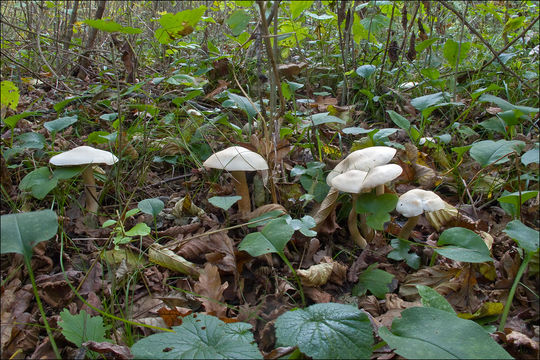Imagem de Tricholoma lascivum (Fr.) Gillet 1874

Descrição:
Slo.: golobija kolobarnica - syn.: Tricholoma album ss. Kuhner & Romagnesi 1953, Gyrophila lasciva (Fr.) Qul. - Habitat: slightly inside light, mixed, unmaintained forest edge with many shrubs; Picea abies, Fagus sylvatica, Corylus avellana, Prunus spinosa, Rubus sp. etc. present; near a small water stream; flat terrain; cretaceous clastic rock (flysh) bedrock with some limestone; humid place, mostly in shade; partly protected from direct rain by tree canopies; average precipitations ~ 3.000 mm/year, average temperature 8-10 deg C, elevation 460 m (1.500 feet), alpine phytogeographical region. Substratum: soil.Comments: There exist four whitish species with similar habit in the genus Tricholoma: Tricholoma album, Tricholoma columbetta, Tricholoma inamoenum and Tricholoma lascivum. Also nomenclature history of these species is 'difficult'. Hence confusion and misidentifications are frequent. From this reason some experts consider published distribution ranges of these species as questionable. MycoBank (Ref.7) states: 'Real distribution poorly known because of the taxonomic confusion with similar species'.This find was at first (based on habit) recognized as Tricholoma inamoenum. However, measured spore dimensions were much too small. Their dimensions and particularly narrow spores (Q exceeding 1.6) speaks in favor of Tricholoma lascivum. Also other macro traits and habitat seems to fit reasonably well to this determination. On the other hand, Tricholoma album is a symbiont with Betula or Quercus, which were not present in the vicinity. Tricholoma columbetta is practically without odor (Ref. 2 and 3) while the find had strong, unpleasant smell on gas or chemistry. Tricholoma album and Tricholoma columbetta also have somewhat smaller spores, while, Tricholoma inamoenum has significantly larger spores.Description: Several fruitbodies present, some clustered; pilei diameter up to 3 - 7(8) cm; smell strong, unpleasant, on gas or some chemistry; taste not tested; SP abundant, white.Spores smooth. Dimensions: (6) 6,3 - 7,6 (8) x (3,5) 3,8 - 4,5 (4,8) microns; Q = (1,4) 1,5 - 1,9 (2,1); N = 35; Me = 6,9 x 4,1 microns; Qe = 1,7. Olympus CH20, NEA 100x/1.25, magnification 1.000 x, oil (spores); in water; fresh material. AmScope MA500 digital camera.Ref.: (1) C. Bas, Th.W.Kuyper, M.E. Nordeloos, E.C. Vellinga (eds.), Flora Agaricina Neerlandica, A.A. Balkema, Vol.4. (1999), p 145.(2) M.Christensen, J. Heilmann-Clausen, The genus Tricholoma, Fungi of Northern Europe, Vol.4. (2013), p 186.(3) J. Breitenbach, F. Kraenzlin, Eds., Fungi of Switzerland, Vol.3. Verlag Mykologia (1991), p 330.(4) https://www.myko.cz/myko-atlas/Tricholoma-lascivum/ (accessed Nov. 4. 2017) (5) G.J. Krieglsteiner (Hrsg.), Die Grosspilze Baden-Wrttembergs, Band 3., Ulmer (2001), p 568.(6) S. Buczacki, Collins Fungi Guide, Collins (2012), p 154.
Incluído nas seguintes páginas:
- Life
- Cellular
- Eukaryota (Eucariontes)
- Opisthokonta
- Nucletmycea
- Fungi
- Dikarya
- Basidiomycota
- Agaricomycetes
- Agaricales
- Tricholomataceae
- Tricholoma
- Tricholoma lascivum
Esta imagem não aparece em nenhuma coleção.
Informação de origem
- licença
- cc-by-nc-sa-3.0
- direitos autorais
- 2017 Dr. Amadej Trnkoczy
- fotógrafo
- Dr. Amadej Trnkoczy
- original
- arquivo de mídia original
- visite a fonte
- site do parceiro
- CalPhotos
- ID


